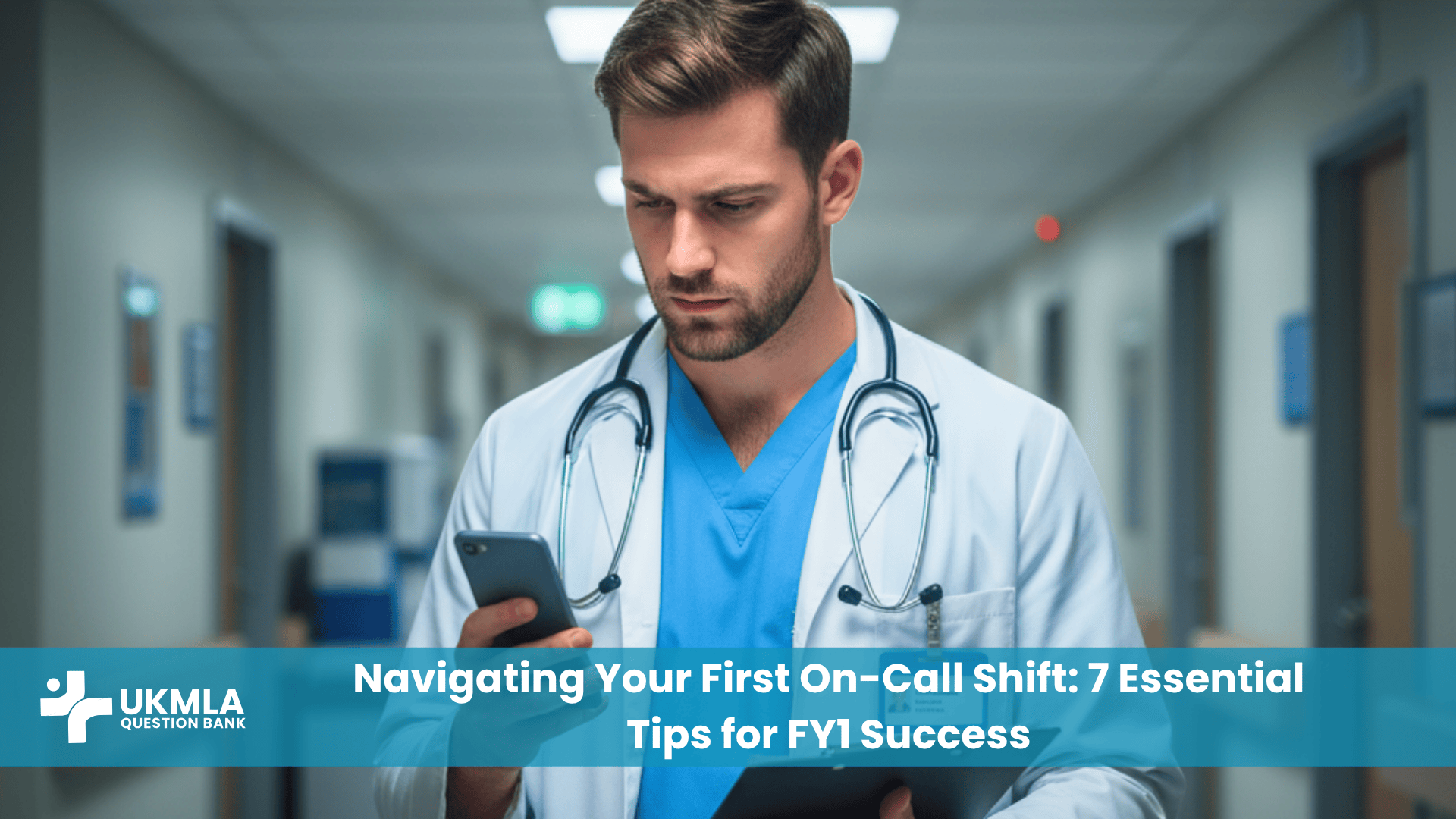Introduction
Your first on-call shift as an FY1 doctor is a significant rite of passage. It represents the moment you transition from a medical student under supervision to a doctor with a bleep, a list of sick patients, and the responsibility to make frontline decisions. The mix of excitement and trepidation is completely normal; you are stepping into one of the most challenging but rewarding roles in medicine. Having passed the UKMLA is a huge achievement, but this is the next practical hurdle on your journey.
This guide is designed to be your trusted companion for that first shift and beyond. We’re moving past the textbook to give you practical, actionable advice that will help you not just survive, but thrive. By focusing on preparation, systematic thinking, and clear communication, you can manage the workload, ensure patient safety, and turn a potentially stressful experience into a massive confidence boost.
Table of Contents
ToggleKey Takeaways
Preparation is Paramount: Your shift starts before you even arrive. Knowing key numbers, passwords, and the location of essential equipment is a non-negotiable first step.
Prioritize Ruthlessly: You cannot do everything at once. Your core skill is to constantly triage your jobs, focusing on the sickest patients first using a clear system.
Communicate Clearly with SBAR: When you need help (and you will), using the SBAR format ensures you get your point across clearly and efficiently every time.
Never Hesitate to Escalate: It is always safer to call for help and not need it than to delay and let a patient deteriorate. A senior colleague will always prefer an early, well-communicated call to a late one.
Why Your First On-Call is a Rite of Passage (And Why It’s Okay to Be Nervous)
Strengthening the “Why”: From Medical Student Theory to Real-World Responsibility
The on-call shift is where the protected learning environment of medical school gives way to the dynamic reality of clinical practice. For the first time, you are often the initial point of contact for a deteriorating patient. The UKMLA ensures you have the core knowledge, but the on-call shift tests your ability to apply it under pressure, manage competing demands, and work effectively within a team.
Examiners and supervisors aren’t looking for encyclopedic knowledge; they’re looking for a safe practitioner. Your ability to recognize a sick patient, perform a basic assessment, and escalate appropriately is far more important than knowing a rare diagnosis. This shift in responsibility is why preparation is so critical. This is the first of many crucial steps after you’ve passed your exams, and it sets the tone for your entire foundation year, as detailed in The UK Graduate’s Essential Guide to Starting FY1.
A 7-Tip Survival Guide for Your First On-Call Shift FY1
Tip 1: The Pre-Call Preparation Checklist (What to Know Before You Start)
Confidence begins with preparation. Before your shift, create a personalized “on-call essentials” list. Arrive 10-15 minutes early to get yourself settled, log in to the computer systems, and mentally prepare for handover.
Table 1: Your On-Call Essentials Checklist
| Category | Essential Items & Information |
|---|---|
| Knowledge | ✓ Your login/passwords for all hospital systems ✓ The hospital’s cardiac arrest bleep number ✓ Your personal bleep number |
| Equipment | ✓ A working black pen (and a spare!) ✓ A stethoscope ✓ Your trust’s ID card/access pass |
| Resources | ✓ BNF and hospital guidelines loaded on your phone ✓ A small notebook for your jobs list |
| Self-Care | ✓ A bottle of water ✓ Some snacks that are easy to eat on the go ✓ Any personal medication you might need |
Tip 2: Master the Handover (How to Receive Information and Not Get Overwhelmed)
The start-of-shift handover is a firehose of information. Listen actively, not passively. Your goal is to leave with a clear, prioritized list of tasks and a mental map of the sickest patients on your list.
Listen to the Tone: Pay attention to the outgoing doctor. Which patients are they most worried about? Their non-verbal cues are as important as their words.
Ask Clarifying Questions: Now is the time to resolve ambiguity. Don’t be afraid to ask:
“Sorry, can you just clarify what the plan is for Mr. Jones’ potassium?”
“For the TTO for Bed 7, are the warfarin doses confirmed?”
“Who is the senior I should contact for that patient if they deteriorate?”
Structure Your Notes: Don’t just write a random list. For each patient, quickly jot down their Location (Ward/Bed), Problem, and the specific Job(s) required. Have a small box you can tick or star for patients identified as being particularly unwell.
Tip 3: The Art of Prioritization (Sick vs. Jobs: A Simple Triage System)
Your bleep will go off constantly. You cannot do everything at once. Your most critical skill is to constantly triage every new task. A simple but effective system is:
Immediate Threat to Life (Emergency): Cardiac arrest call, major haemorrhage, anaphylaxis, seizing patient. You must go immediately. This overrides everything else.
Acutely Unwell Patient (Urgent Review): A high NEWS2 score (e.g., >7), sudden hypotension, new confusion, decreased GCS, severe shortness of breath. You must see this patient within minutes.
Urgent Tasks: Prescribing time-critical medications (IV antibiotics, analgesia for severe pain), reviewing critical blood results (high potassium, low haemoglobin), assessing a patient a nurse is very worried about. These should be done as soon as your current urgent task is complete.
Non-Urgent Tasks: Rewriting a fluid chart, prescribing sleeping tablets, chasing a routine scan for the next day, writing a non-urgent TTO. These tasks are important, but they can wait. Group them together to complete when you have a moment of quiet.
Tip 4: Communicate Like a Pro with SBAR
When you call for help, you need to be clear, concise, and structured. SBAR (Situation, Background, Assessment, Recommendation) is the universal language of safe healthcare communication. It ensures you don’t miss key information and helps your senior quickly grasp the problem. Before you even dial, take 30 seconds to gather your thoughts and have the patient’s notes and latest observations in front of you. This skill is vital for all clinical communication, especially when Mastering the Telephone Consultation.
Tip 5: Know Your Lifelines (Who to Call for Help and When)
You are never alone on an on-call shift. Knowing who to call, and for what, is a sign of competence, not weakness. Your “lifelines” include:
The Ward Nurses: They are your greatest allies. If an experienced nurse tells you they are worried about a patient, you must take it seriously, even if the observations seem stable.
Your SHO or Registrar: This is your first port of call for any clinical uncertainty or a deteriorating patient.
Specialist Teams: For specific problems, call the relevant team. Don’t ask the medical registrar about a dislodged surgical drain. Call the on-call surgical SHO.
Hospital Switchboard: They are the gatekeepers to all on-call rotas and can connect you to the on-call specialist for any team in the hospital.
Official Guidelines: Resources like the NICE guideline on acutely ill adults (CG50) provide a robust, evidence-based framework for managing deteriorating patients.
Tip 6: Don’t Neglect Self-Care Basics (Eating, Drinking, and Strategic Rest)
You cannot care for others if you are not caring for yourself. Burnout is real, and it starts with neglecting the basics. Dehydration and hunger lead to poor concentration and bad decision-making.
Stay Hydrated: Carry a water bottle and refill it.
Pack Smart Snacks: Don’t rely on the hospital canteen being open at 3 AM. Protein bars, fruit, and nuts are good options.
Take Your Breaks: The jobs list will never be empty. You must actively choose to take a break. Even 15 minutes away from the ward to sit down, eat, and clear your head can make a huge difference to your performance and mental state. Maintaining The Winning Mindset for UKMLA Success includes treating rest as a strategic part of your professional practice.
Tip 7: The Golden Rule – When in Doubt, Escalate Early
This is the most important rule of your first on-call shift as an FY1 and your entire career. It is always safer for the patient for you to call for help early.
“I have never, ever criticized a junior doctor for calling me too early about a patient they were worried about. I have, however, been in many difficult situations because a call came too late. If you are worried, I want to know.” — Senior Medical Registrar
A good senior will respect you for knowing your limits. A call that starts with “I’m sorry to bother you, but I’m worried about this patient and I’m not sure what to do next” is the mark of a safe, responsible doctor.
Actionability Enhancement: Practical Scripts & Checklists
“What to Say”: A Script for Escalating to Your Senior
Use this SBAR template when you call your registrar.
“What to Say” Script:
(Before you call, have the patient’s notes and recent observations ready)
S (Situation): “Hi, it’s [Your Name], the FY1 on call. I’m calling about Mr. Smith in Bed 4 on Ward 10. His NEWS2 score has just increased to 8 due to a new tachycardia of 130 and a respiratory rate of 28.”
B (Background): “He’s an 82-year-old man admitted yesterday with a community-acquired pneumonia. He’s currently on IV Co-amoxiclav.”
A (Assessment): “I’ve just assessed him. His chest has coarse crackles at the right base, his blood pressure is stable at 110/70, but he looks tired and is struggling to speak in full sentences. My main concern is that he is developing sepsis.”
R (Recommendation): “I think he needs an urgent senior review. While I wait for you, I’m going to get an ABG, repeat bloods including a lactate, and get a portable chest x-ray. Is there anything else you’d like me to do?”
Frequently Asked Questions (FAQ) about the First On-Call Shift
The most common mistake is trying to handle everything alone and escalating too late. This often stems from a fear of looking incompetent or “bothering” a senior. From an examiner’s perspective, demonstrating an early and appropriate escalation for a sick patient is a sign of a safe and highly competent doctor. A good senior would much rather provide advice early than be called to a crash call that could have been prevented.
This requires ruthless prioritization (Tip 3). Your immediate action should be to quickly triage each request. A useful phrase is: “I’m just with another patient, is this an emergency?” This allows you to quickly determine if you need to drop what you’re doing or if the new task can be added to your list. It is perfectly acceptable and professional to manage expectations by stating your current workload.
Always go and see the patient. An experienced nurse’s intuition, often called a “gut feeling,” is an incredibly valuable diagnostic tool. They have seen hundreds of patients and can often spot subtle signs of deterioration—like a change in colour or behavior—before they are reflected in the NEWS2 score. Ignoring a nurse’s concern is a major pitfall; trust your colleagues.
You must be honest about your competency. Your primary duty is to the patient’s safety. A safe and professional script is: “I’ve only done that procedure once before under supervision. To ensure it’s done safely for the patient, could you or someone else come and supervise me for this one?” This is not a sign of weakness; it’s a sign of maturity and professionalism that seniors will respect.
Your personal safety is the priority. Always maintain a calm and professional demeanor, listen to their concerns without getting drawn into an argument, and try to find a quiet space to talk. If you feel threatened or the situation is escalating, remove yourself and get help immediately from senior nursing staff or hospital security. Our guide to Managing Challenging Scenarios has useful communication frameworks for these situations.
Use a small, dedicated notebook. When a job is bleeped to you, write it down immediately with the patient’s location and a brief summary. When you complete a job, cross it off satisfyingly. Before the end of your shift, do a final review of your list to ensure no tasks have been forgotten before you hand over. This simple system is far more reliable than trying to remember everything during a busy shift.
You must be open and honest immediately. This is a cornerstone of professional practice. Your first action is to ensure the patient is safe. Your second action is to inform your senior (your SHO or registrar) straight away, even if the mistake seems minor. Hiding a mistake is a far more serious professional error than making one, and a supportive team will help you learn from it.
Be cautious and systematic. If you are prescribing a new, unfamiliar, or high-risk drug, always take an extra minute to double-check the dose, frequency, and potential contraindications in the BNF. If you are unsure about an antibiotic, check your hospital’s local microbiology guidelines. It’s better to be seen as slow and safe than fast and reckless.
Your primary role as the first FY1 on the scene is simple but critical: get help if it’s not already coming, start basic life support (high-quality chest compressions), and provide a clear, concise SBAR handover when the crash team arrives. Do not be afraid to state clearly, “I’m the FY1, I was the first here.” The team will have clear roles, and they will direct you on how you can best help.
Yes. It is one of the safest and most important phrases you can use on your first on-call shift as an FY1. Saying “I don’t know, but I will find out” or “I don’t know, I need to ask for senior advice” is a sign of a safe, self-aware doctor. An examiner or a senior colleague will always reward this honesty over a confident but incorrect guess.
Conclusion: Your Next Steps
Your first on-call shift is a significant milestone that marks the true beginning of your clinical autonomy. The key to not just surviving but succeeding is to replace anxiety with a systematic approach. By preparing properly, prioritizing effectively, communicating clearly, and knowing when to ask for help, you demonstrate the core competencies of a safe and reliable junior doctor.
These tips are not just for one shift; they are the building blocks for a resilient and competent career. Each on-call you complete will build your confidence and experience. Embrace the learning opportunity, support your colleagues, and always put patient safety first.
Practice Exercise: Prioritizing a Bleep List
Scenario: You receive these three bleeps in quick succession while writing in the notes. In which order do you deal with them?
Ward 5: "Can you prescribe paracetamol for Bed 12, she has a headache."Ward 7: "Hi, it's the nurse for Mr. Jones in Bed 3. I'm worried about him. His new oxygen requirement has gone up to 4L and he looks unwell."A&E: "Can you come down to review a patient for the evening team? They think it's a simple TTO."
Your Task: Rank them 1 (highest priority) to 3 (lowest priority). (Answer: 1. Ward 7, 2. A&E, 3. Ward 5. The potentially sick patient is always the top priority, followed by helping out another team, followed by the non-urgent routine job.)



